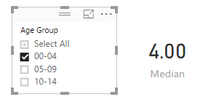Join us at FabCon Vienna from September 15-18, 2025
The ultimate Fabric, Power BI, SQL, and AI community-led learning event. Save €200 with code FABCOMM.
Get registered- Power BI forums
- Get Help with Power BI
- Desktop
- Service
- Report Server
- Power Query
- Mobile Apps
- Developer
- DAX Commands and Tips
- Custom Visuals Development Discussion
- Health and Life Sciences
- Power BI Spanish forums
- Translated Spanish Desktop
- Training and Consulting
- Instructor Led Training
- Dashboard in a Day for Women, by Women
- Galleries
- Data Stories Gallery
- Themes Gallery
- Contests Gallery
- Quick Measures Gallery
- Notebook Gallery
- Translytical Task Flow Gallery
- TMDL Gallery
- R Script Showcase
- Webinars and Video Gallery
- Ideas
- Custom Visuals Ideas (read-only)
- Issues
- Issues
- Events
- Upcoming Events
Enhance your career with this limited time 50% discount on Fabric and Power BI exams. Ends September 15. Request your voucher.
- Power BI forums
- Forums
- Get Help with Power BI
- Desktop
- How to calculate median by summing values of selec...
- Subscribe to RSS Feed
- Mark Topic as New
- Mark Topic as Read
- Float this Topic for Current User
- Bookmark
- Subscribe
- Printer Friendly Page
- Mark as New
- Bookmark
- Subscribe
- Mute
- Subscribe to RSS Feed
- Permalink
- Report Inappropriate Content
How to calculate median by summing values of selected groups
| Market | Age Group | Population |
| Country A | 00-04 | 1 |
| Country A | 05-09 | 2 |
| Country A | 10-14 | 3 |
| Country B | 00-04 | 4 |
| Country B | 05-09 | 5 |
| Country B | 10-14 | 6 |
| Country C | 00-04 | 7 |
| Country C | 05-09 | 8 |
| Country C | 10-14 | 9 |

Solved! Go to Solution.
- Mark as New
- Bookmark
- Subscribe
- Mute
- Subscribe to RSS Feed
- Permalink
- Report Inappropriate Content
Hi @AC1223,
Based on my test, the formula below should work in your scenario. ![]()
Measure =
MEDIANX (
SUMMARIZE (
Table1,
Table1[Market],
"Total Population", SUM ( Table1[Population] )
),
[Total Population]
)
Just replace Table1 with your real table name.
Regards
- Mark as New
- Bookmark
- Subscribe
- Mute
- Subscribe to RSS Feed
- Permalink
- Report Inappropriate Content
- Mark as New
- Bookmark
- Subscribe
- Mute
- Subscribe to RSS Feed
- Permalink
- Report Inappropriate Content
I created this measure below ( my table is called DataSelect):
Measure = DIVIDE ( SUM ( DataSelect[Population] ), DISTINCTCOUNT ( DataSelect[Market] ), BLANK () )
You have the output below, please let us know if it is not your expected results.
Ninter.
- Mark as New
- Bookmark
- Subscribe
- Mute
- Subscribe to RSS Feed
- Permalink
- Report Inappropriate Content
Hi Interkoubess,
Thankyou for your response.
The results are right in this case, but this is not calculating the median.
It does not work with other numbers.
eg, if I change the dataset to below:
| Market | Age Group | Population |
| Country A | 00-04 | 1 |
| Country A | 05-09 | 100 |
| Country A | 10-14 | 7 |
| Country B | 00-04 | 80 |
| Country B | 05-09 | 5 |
| Country B | 10-14 | 2000 |
| Country C | 00-04 | 30 |
| Country C | 05-09 | 2 |
| Country C | 10-14 | 50 |
- Mark as New
- Bookmark
- Subscribe
- Mute
- Subscribe to RSS Feed
- Permalink
- Report Inappropriate Content
Hi @AC1223,
Based on my test, the formula below should work in your scenario. ![]()
Measure =
MEDIANX (
SUMMARIZE (
Table1,
Table1[Market],
"Total Population", SUM ( Table1[Population] )
),
[Total Population]
)
Just replace Table1 with your real table name.
Regards
- Mark as New
- Bookmark
- Subscribe
- Mute
- Subscribe to RSS Feed
- Permalink
- Report Inappropriate Content




